Optimal Placement of Distributed Generation Based on Power Quality Improvement Using Self-Adaptive Lévy Flight Jaya Algorithm
Abstract
:1. Introduction
- Determination of optimal location and size for multiple DG units based on power quality in terms of voltage deviation from the flat voltage profile
- A self-adaptive Lévy flight Jaya algorithm (SALFJA) representing an improved version of the Jaya algorithm by the addition of Lévy flight for extensive search is used for optimal DG placement
- The performance of the proposed method is validated in a stochastic environment
- The power quality of the distribution system is mathematically modeled as a sum of squares of voltage deviation at each bus from the flat voltage profile
2. Methodology
2.1. Mathematical Modeling of DG Placement
2.2. Self-Adaptive Lévy Flight Jaya Algorithm (SALFJA)
3. Results Analysis
3.1. Case Study—01: IEEE 15 Bus Radial Distribution System
3.2. Case Study—02: PG & E 69 Bus Radial Distribution System
4. Conclusions
Author Contributions
Funding
Institutional Review Board Statement
Informed Consent Statement
Data Availability Statement
Conflicts of Interest
Abbreviations
| DG | Distributed generation |
| TSVD | Total system voltage deviation |
| PQ | Power quality |
| DISCOs | Distribution companies |
| P(i) | Generation from DG unit |
| Power demand | |
| Active power loss | |
| Apparent power in feeder ‘i’ | |
| Thermal limit for feeder ‘i’ | |
| V(i) | Voltage at bus |
| Location for DG | |
| Size for DG |
References
- Raut, U.; Mishra, S. A new Pareto multi-objective sine cosine algorithm for performance enhancement of radial distribution network by optimal allocation of distributed generators. Evol. Intell. 2020, 14, 1635–1656. [Google Scholar] [CrossRef]
- Kawambwa, S.; Hamisi, N.; Mafole, P.; Kundaeli, H. A cloud model based symbiotic organism search algorithm for DG allocation in radial distribution network. Evol. Intell. 2021, 15, 545–562. [Google Scholar] [CrossRef]
- Awad, A.; Abdel-Mawgoud, H.; Kamel, S.; Ibrahim, A.A.; Jurado, F. Developing a Hybrid Optimization Algorithm for Optimal Allocation of Renewable DGs in Distribution Network. Clean Technol. 2021, 3, 409–423. [Google Scholar] [CrossRef]
- Chattopadhyay, S.; Mitra, M.; Sengupta, S. Electric Power Quality; Springer: Berlin/Heidelberg, Germany, 2011; pp. 5–12. [Google Scholar]
- Veeramsetty, V.; Lakshmi, G.N.; Jayalaxmi, A. Optimal allocation and contingency analysis of embedded generation deployment in distribution network using genetic algorithm. In Proceedings of the 2012 International Conference on Computing, Electronics and Electrical Technologies (ICCEET), Nagercoil, India, 21–22 March 2012; pp. 86–91. [Google Scholar]
- Lakshmi, G.N.; Jayalaxmi, A.; Veeramsetty, V. Optimal placement of distributed generation using firefly algorithm. In Proceedings of the IOP Conference Series: Materials Science and Engineering, Ulaanbaatar, Mongolia, 10–13 September 2020; Volume 981, p. 042060. [Google Scholar]
- Lakshmi, G.N.; Jayalaxmi, A.; Veeramsetty, V. Optimal Placement of Distribution Generation in Radial Distribution System Using Hybrid Genetic Dragonfly Algorithm. Technol. Econ. Smart Grids Sustain. Energy 2021, 6, 1–13. [Google Scholar] [CrossRef]
- Venkata, N.L.G.; Askani, J.L.; Veeramsetty, V. Optimal placement of distributed generation based on DISCO’s additional benefit using self adaptive Lévy flight based black widow optimization. Int. J. Emerg. Electr. Power Syst. 2021, 22, 401–410. [Google Scholar] [CrossRef]
- Mohanty, P.K.; Lal, D.K. Voltage stability index and butterfly optimization algorithm-based DG placement and sizing in electrical power distribution system. In Green Technology for Smart City and Society; Springer: Berlin/Heidelberg, Germany, 2021; pp. 311–326. [Google Scholar]
- Suresh, M.; Edward, J.B. A hybrid algorithm based optimal placement of DG units for loss reduction in the distribution system. Appl. Soft Comput. 2020, 91, 106191. [Google Scholar] [CrossRef]
- Almabsout, E.A.; El-Sehiemy, R.A.; An, O.N.U.; Bayat, O. A hybrid local search-genetic algorithm for simultaneous placement of DG units and shunt capacitors in radial distribution systems. IEEE Access 2020, 8, 54465–54481. [Google Scholar] [CrossRef]
- Pal, A.; Chakraborty, A.K.; Bhowmik, A.R. Optimal placement and sizing of DG considering power and energy loss minimization in distribution system. Int. J. Electr. Eng. Inform. 2020, 12, 624–653. [Google Scholar] [CrossRef]
- Manna, D.; Goswami, S.K. Optimum placement of distributed generation considering economics as well as operational issues. Int. Trans. Electr. Energy Syst. 2020, 30, e12246. [Google Scholar] [CrossRef]
- Li, Y.; Zhang, H.; Liang, X.; Huang, B. Event-triggered-based distributed cooperative energy management for multienergy systems. IEEE Trans. Ind. Inform. 2018, 15, 2008–2022. [Google Scholar] [CrossRef]
- Karimi, H.; Niknam, T.; Dehghani, M.; Ghiasi, M.; Ghasemigarpachi, M.; Padmanaban, S.; Tabatabaee, S.; Aliev, H. Automated distribution networks reliability optimization in the presence of DG units considering probability customer interruption: A practical case study. IEEE Access 2021, 9, 98490–98505. [Google Scholar] [CrossRef]
- Sheng, W.; Liu, K.Y.; Liu, Y.; Meng, X.; Li, Y. Optimal Placement and Sizing of Distributed Generation via an Improved Nondominated Sorting Genetic Algorithm II. IEEE Trans. Power Deliv. 2015, 30, 569–578. [Google Scholar] [CrossRef]
- Avar, A.; Sheikh-El-Eslami, M.K. Optimal DG placement in power markets from DG Owners’ perspective considering the impact of transmission costs. Electr. Power Syst. Res. 2021, 196, 107218. [Google Scholar] [CrossRef]
- Shaik, M.A.; Mareddy, P.L.; Visali, N. Enhancement of Voltage Profile in the Distribution system by Reconfiguring with DG placement using Equilibrium Optimizer. Alex. Eng. J. 2021, 61, 4081–4093. [Google Scholar] [CrossRef]
- Dashtdar, M.; Najafi, M.; Esmaeilbeig, M. Reducing LMP and resolving the congestion of the lines based on placement and optimal size of DG in the power network using the GA-GSF algorithm. Electr. Eng. 2021, 103, 1279–1306. [Google Scholar] [CrossRef]
- Manas, M.; Saikia, B.J.; Baruah, D.C. Optimal distributed generator sizing and placement by analytical method and fuzzy expert system: A case study in Tezpur University, India. Technol. Econ. Smart Grids Sustain. Energy 2018, 3, 1–12. [Google Scholar] [CrossRef] [Green Version]
- Vempalle, R.; Dhal, P. Loss minimization by reconfiguration along with distributed generator placement at radial distribution system with hybrid optimization techniques. Technol. Econ. Smart Grids Sustain. Energy 2020, 5, 1–12. [Google Scholar] [CrossRef]
- Jalili, A.; Taheri, B. Optimal sizing and sitting of distributed generations in power distribution networks using firefly algorithm. Technol. Econ. Smart Grids Sustain. Energy 2020, 5, 1–14. [Google Scholar] [CrossRef] [Green Version]
- Venkatesan, Y.; Srilakshmi, K.; Palanivelu, A. Modified soccer game optimization and its application on power flow and distribution generation placement problems of distribution systems. Evol. Intell. 2021, 1–14. [Google Scholar] [CrossRef]
- Lekhuleni, T.; Twala, B. Distributed Optimal Placement Generators in a Medium Voltage Redial Feeder. Symmetry 2022, 14, 1729. [Google Scholar] [CrossRef]
- Elseify, M.A.; Kamel, S.; Abdel-Mawgoud, H.; Elattar, E.E. A Novel Approach Based on Honey Badger Algorithm for Optimal Allocation of Multiple DG and Capacitor in Radial Distribution Networks Considering Power Loss Sensitivity. Mathematics 2022, 10, 2081. [Google Scholar] [CrossRef]
- Abbas, A.; Qaisar, S.M.; Waqar, A.; Ullah, N.; Al Ahmadi, A.A. Min-Max Regret-Based Approach for Sizing and Placement of DGs in Distribution System under a 24 h Load Horizon. Energies 2022, 15, 3701. [Google Scholar] [CrossRef]
- Gallego Pareja, L.A.; López-Lezama, J.M.; Gómez Carmona, O. A Mixed-Integer Linear Programming Model for the Simultaneous Optimal Distribution Network Reconfiguration and Optimal Placement of Distributed Generation. Energies 2022, 15, 3063. [Google Scholar] [CrossRef]
- Adeagbo, A.P.; Ariyo, F.K.; Makinde, K.A.; Salimon, S.A.; Adewuyi, O.B.; Akinde, O.K. Integration of Solar Photovoltaic Distributed Generators in Distribution Networks Based on Site’s Condition. Solar 2022, 2, 52–63. [Google Scholar] [CrossRef]
- Prakash, P.; Meena, D.C.; Malik, H.; Alotaibi, M.A.; Khan, I.A. A Novel Analytical Approach for Optimal Integration of Renewable Energy Sources in Distribution Systems. Energies 2022, 15, 1341. [Google Scholar] [CrossRef]
- Prakash, P.; Meena, D.C.; Malik, H.; Alotaibi, M.A.; Khan, I.A. A Novel Hybrid Approach for Optimal Placement of Non-Dispatchable Distributed Generations in Radial Distribution System. Mathematics 2021, 9, 3171. [Google Scholar] [CrossRef]
- Ramadan, A.; Ebeed, M.; Kamel, S.; Mosaad, M.I.; Abu-Siada, A. Technoeconomic and Environmental Study of Multi-Objective Integration of PV/Wind-Based DGs Considering Uncertainty of System. Electronics 2021, 10, 3035. [Google Scholar] [CrossRef]
- Adewuyi, O.B.; Adeagbo, A.P.; Adebayo, I.G.; Howlader, H.O.R.; Sun, Y. Modified analytical approach for PV-DGs integration into a radial distribution network considering loss sensitivity and voltage stability. Energies 2021, 14, 7775. [Google Scholar] [CrossRef]
- Kazmi, S.A.A.; Shin, D.R. DG placement in loop distribution network with new voltage stability index and loss minimization condition based planning approach under load growth. Energies 2017, 10, 1203. [Google Scholar] [CrossRef] [Green Version]
- Ali, A.; Padmanaban, S.; Twala, B.; Marwala, T. Electric power grids distribution generation system for optimal location and sizing—A case study investigation by various optimization algorithms. Energies 2017, 10, 960. [Google Scholar] [CrossRef]
- Mahesh, K.; Nallagownden, P.; Elamvazuthi, I. Advanced Pareto front non-dominated sorting multi-objective particle swarm optimization for optimal placement and sizing of distributed generation. Energies 2016, 9, 982. [Google Scholar] [CrossRef] [Green Version]
- Shahzad, M.; Ahmad, I.; Gawlik, W.; Palensky, P. Load concentration factor based analytical method for optimal placement of multiple distribution generators for loss minimization and voltage profile improvement. Energies 2016, 9, 287. [Google Scholar] [CrossRef] [Green Version]
- Veeramsetty, V.; Chintham, V.; DM, V.K. LMP computation at DG buses in radial distribution system. Int. J. Energy Sect. Manag. 2018, 12, 364–385. [Google Scholar] [CrossRef]
- Veeramsetty, V.; Chintham, V.; Vinod Kumar, D. Proportional nucleolus game theory–based locational marginal price computation for loss and emission reduction in a radial distribution system. Int. Trans. Electr. Energy Syst. 2018, 28, e2573. [Google Scholar] [CrossRef]
- Veeramsetty, V.; Chintham, V.; Vinod Kumar, D.M. Probabilistic locational marginal price computation in radial distribution system based on active power loss reduction. IET Gener. Transm. Distrib. 2020, 14, 2292–2302. [Google Scholar] [CrossRef]
- Veeramsetty, V.; Chintham, V.; DM, V.K. Locational marginal price computation in radial distribution system using Self Adaptive Lévy Flight based Jaya Algorithm and game theory. Int. J. Emerg. Electr. Power Syst. 2021, 22, 215–231. [Google Scholar] [CrossRef]
- Basetti, V.; Chandel, A.K.; Subramanyam, K. Power system static state estimation using JADE-adaptive differential evolution technique. Soft Comput. 2018, 22, 7157–7176. [Google Scholar] [CrossRef]
- Rao, R. Jaya: A simple and new optimization algorithm for solving constrained and unconstrained optimization problems. Int. J. Ind. Eng. Comput. 2016, 7, 19–34. [Google Scholar]
- Veeramsetty, V.; Venkaiah, C.; Kumar, D.V. Hybrid genetic dragonfly algorithm based optimal power flow for computing LMP at DG buses for reliability improvement. Energy Syst. 2018, 9, 709–757. [Google Scholar] [CrossRef]
- Goldberg, D.E.; Holland, J.H. Genetic Algorithms and Machine Learning. Mach. Learn. 1988, 3, 95–99. [Google Scholar] [CrossRef]
- Eberhart, R.; Kennedy, J. A new optimizer using particle swarm theory. In Proceedings of the MHS’95, Sixth International Symposium on Micro Machine and Human Science, Nagoya, Japan, 4–6 October 1995; pp. 39–43. [Google Scholar]
- Ryan, T.P. Statistical Methods for Quality Improvement; John Wiley & Sons: Hoboken, NJ, USA, 2011. [Google Scholar]
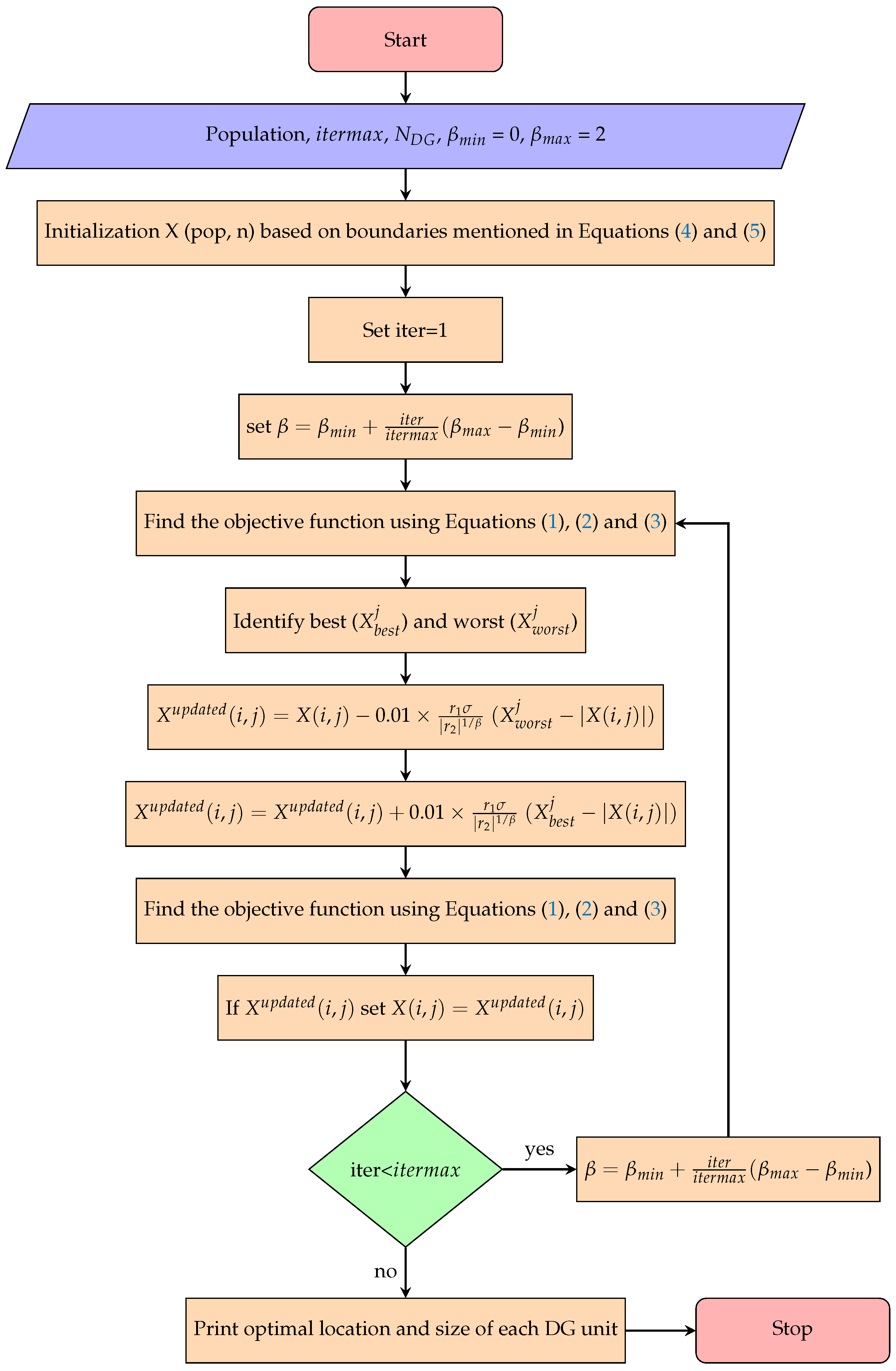
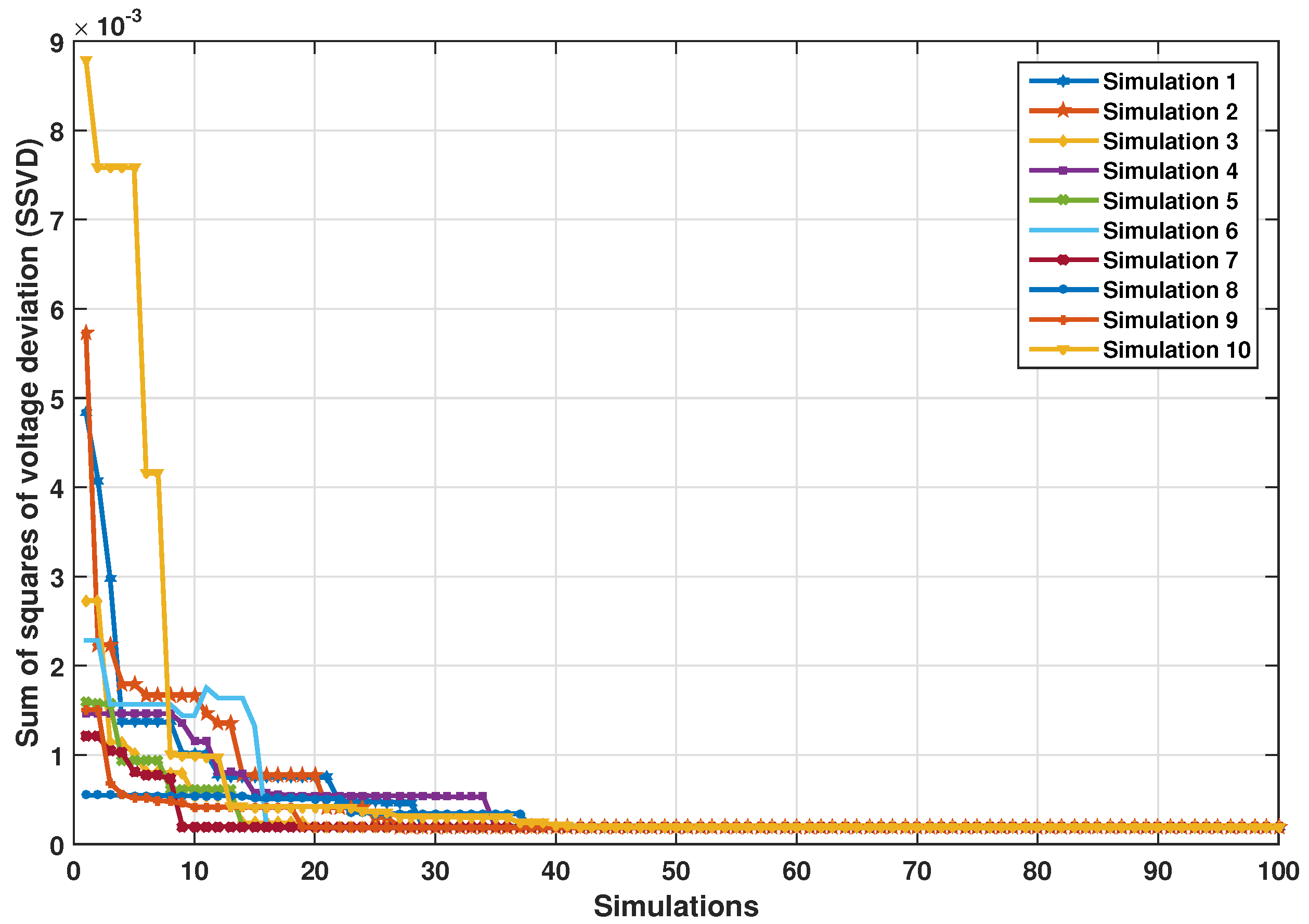
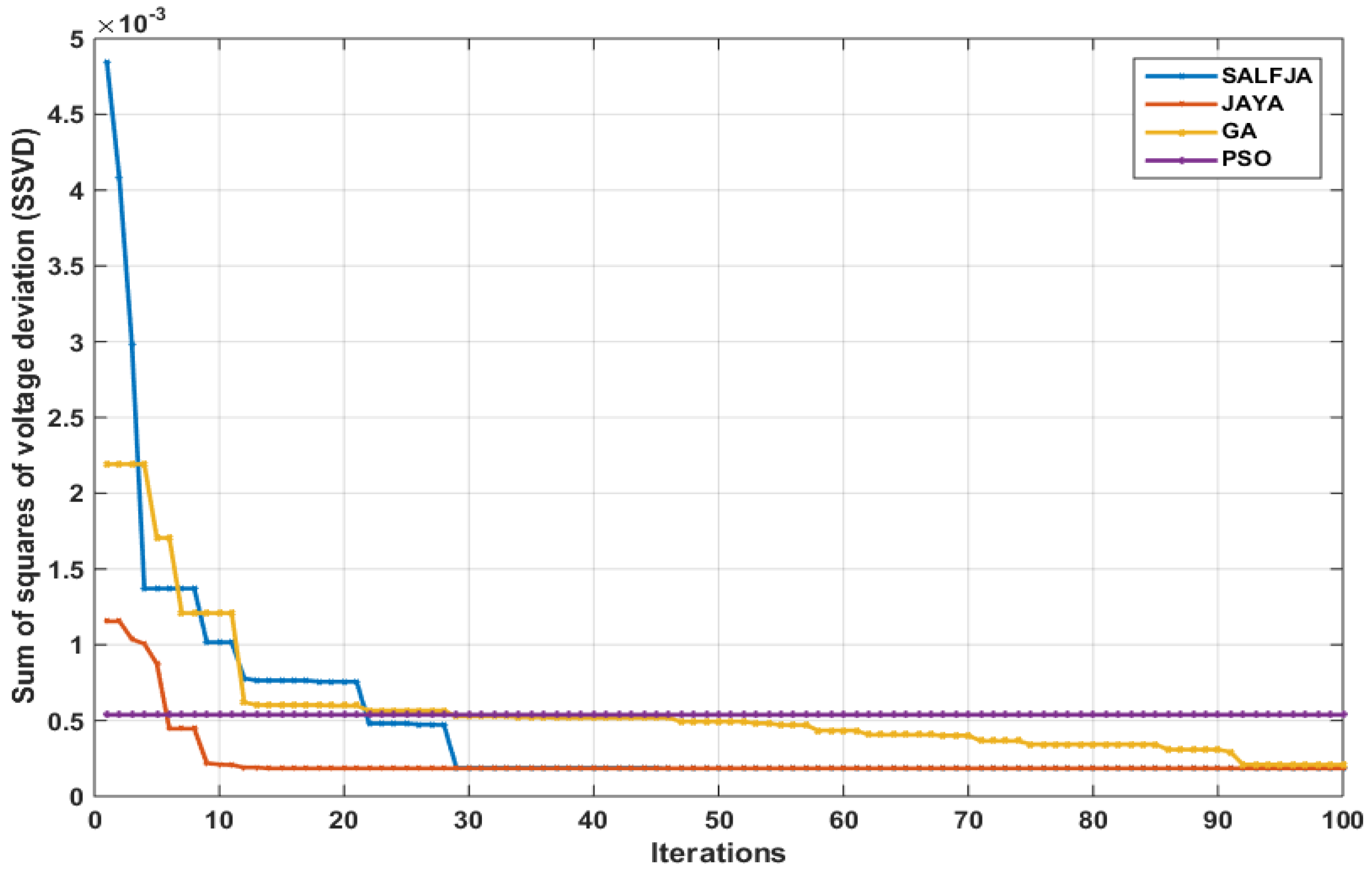
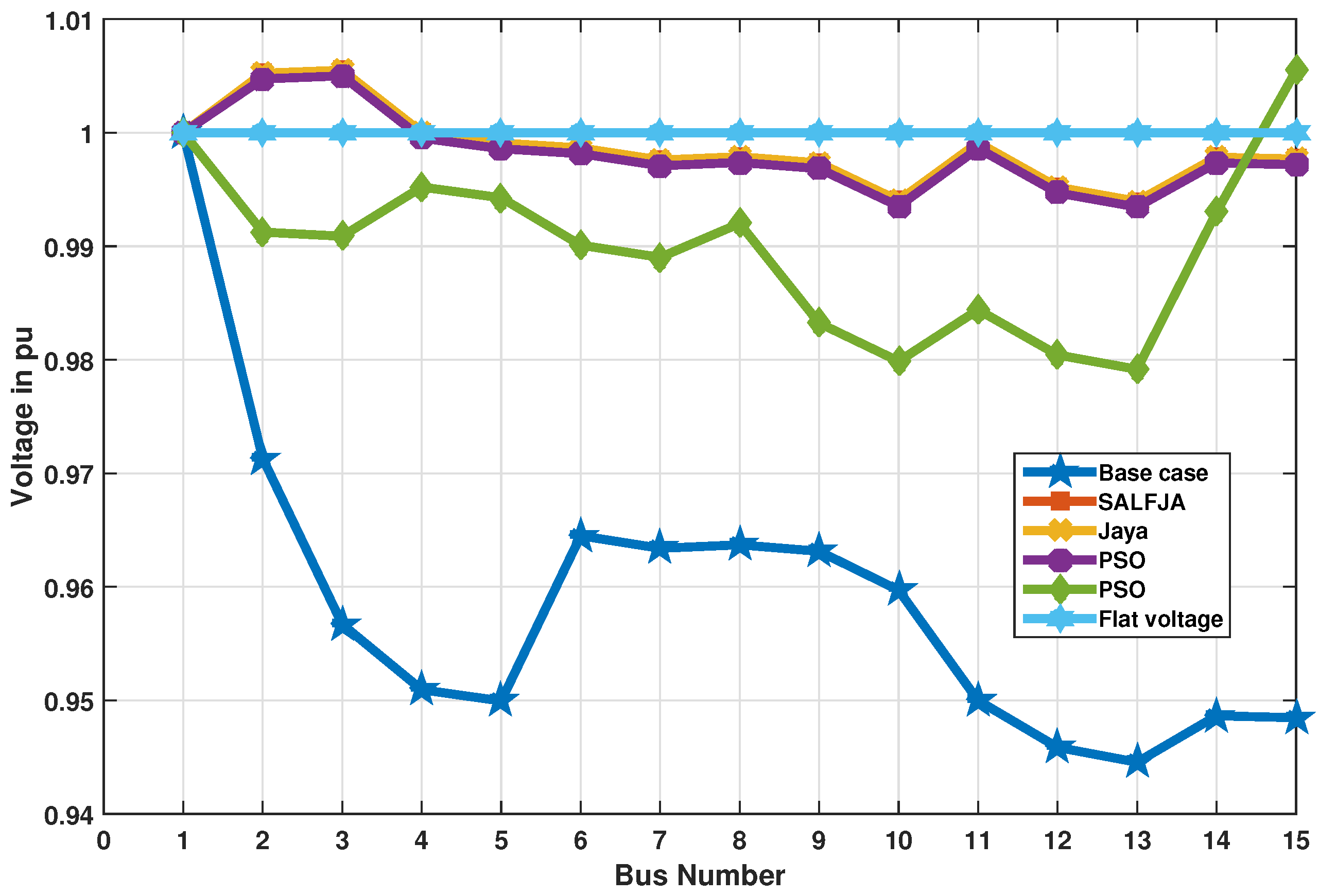
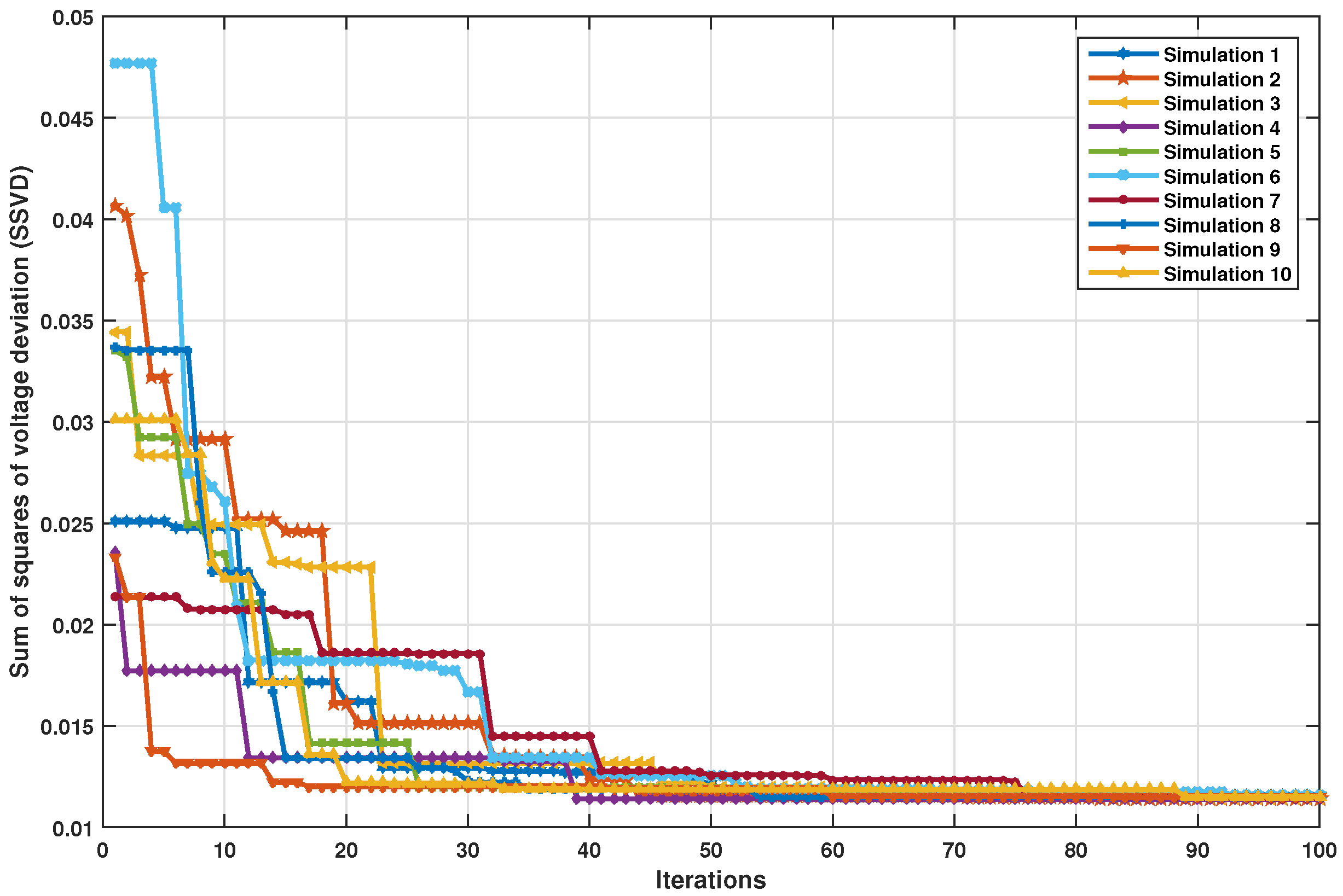

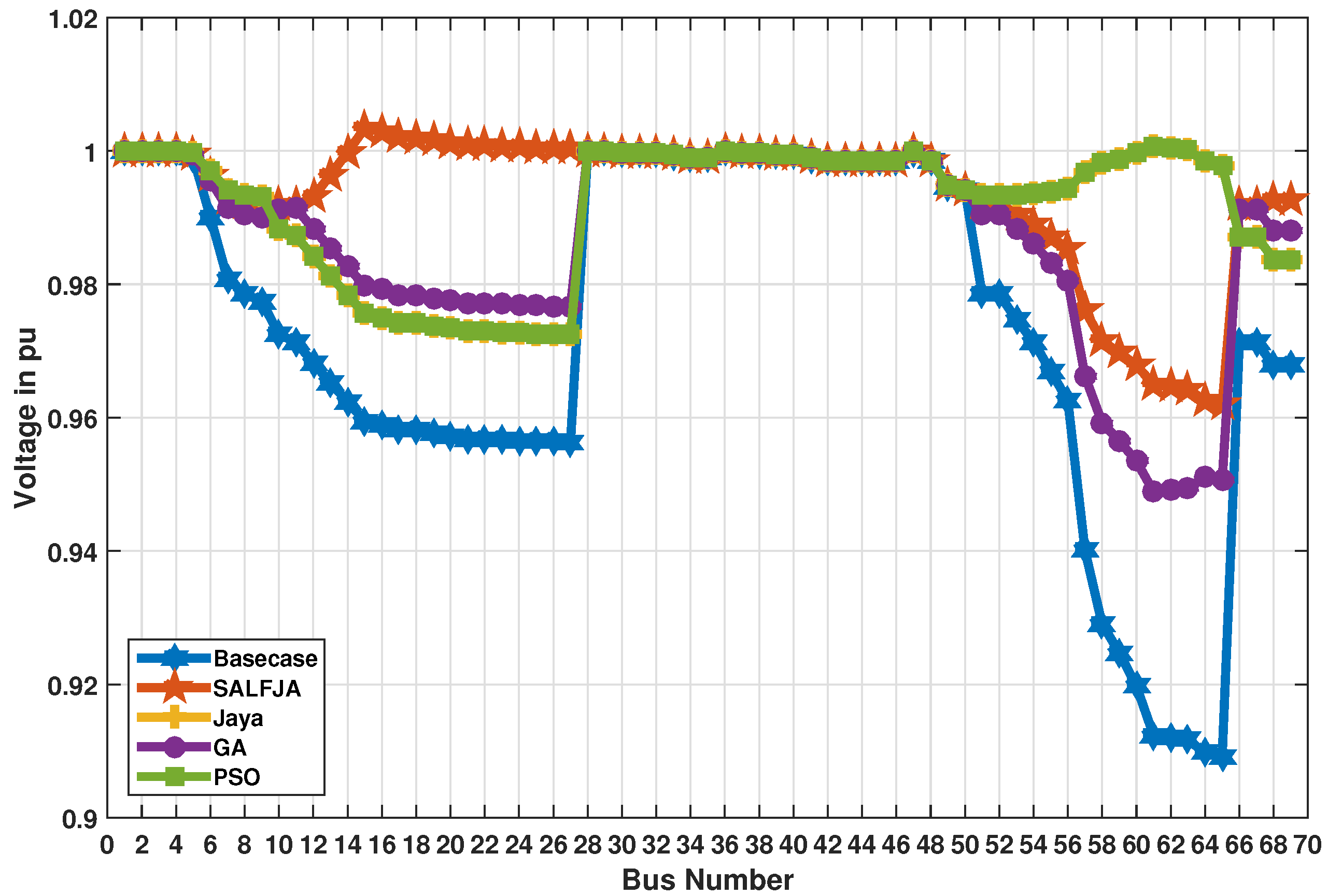
| Simulation | TSVD | Simulation | TSVD |
|---|---|---|---|
| 1 | 0.00018 | 6 | 0.00018 |
| 2 | 0.00018 | 7 | 0.00018 |
| 3 | 0.00018 | 8 | 0.00018 |
| 4 | 0.00018 | 9 | 0.00018 |
| 5 | 0.00018 | 10 | 0.00018 |
| Min | 0.00018 | Max | 0.00018 |
| Mean | 0.00018 | Std. | 0 |
| DG1 | DG2 | ||||
|---|---|---|---|---|---|
| Location | Size | Location | Size | TSVD | Base Case TSVD |
| 2 | 1 MW | 3 | 1 MW | 0.00018 | 0.0283 |
| Simulation | SALFJA | Jaya | GA | PSO |
|---|---|---|---|---|
| 1 | 0.00018 | 0.00018 | 0.00087 | 0.00090 |
| 2 | 0.00018 | 0.00018 | 0.00057 | 0.00093 |
| 3 | 0.00018 | 0.00018 | 0.00095 | 0.00054 |
| 4 | 0.00018 | 0.00018 | 0.00077 | 0.00095 |
| 5 | 0.00018 | 0.00018 | 0.00021 | 0.00079 |
| 6 | 0.00018 | 0.00018 | 0.00078 | 0.00232 |
| 7 | 0.00018 | 0.00018 | 0.00055 | 0.00074 |
| 8 | 0.00018 | 0.00018 | 0.00084 | 0.00106 |
| 9 | 0.00018 | 0.00018 | 0.00051 | 0.00056 |
| 10 | 0.00018 | 0.00018 | 0.00094 | 0.00091 |
| Min | 0.00018 | 0.00018 | 0.00021 | 0.00054 |
| Max | 0.00018 | 0.00018 | 0.00095 | 0.00232 |
| Mean | 0.00018 | 0.00018 | 0.000699 | 0.00097 |
| Std | 0 | 0 | 0.000235 | 0.000503 |
| p-value | - | - | 3.18 × 10 | 0.000388 |
| Simulation | TSVD | Simulation | TSVD |
|---|---|---|---|
| 1 | 0.01161 | 6 | 0.01158 |
| 2 | 0.01142 | 7 | 0.01142 |
| 3 | 0.01139 | 8 | 0.01147 |
| 4 | 0.01138 | 9 | 0.01147 |
| 5 | 0.01155 | 10 | 0.01152 |
| Min | 0.01138 | Max | 0.01161 |
| Mean | 0.011481 | Std. | 0.000081 |
| DG1 | DG2 | ||||
|---|---|---|---|---|---|
| Location | Size | Location | Size | TSVD | Base Case TSVD |
| 61 | 1 MW | 15 | 0.82 MW | 0.01138 | 0.0993 |
| Simulation | SALFJA | Jaya | GA | PSO |
|---|---|---|---|---|
| 1 | 0.01161 | 0.01580 | 0.05750 | 0.02131 |
| 2 | 0.01142 | 0.01155 | 0.02872 | 0.02424 |
| 3 | 0.01139 | 0.01187 | 0.01618 | 0.02001 |
| 4 | 0.01138 | 0.01187 | 0.05025 | 0.02135 |
| 5 | 0.01155 | 0.01667 | 0.02419 | 0.01241 |
| 6 | 0.01158 | 0.01986 | 0.03762 | 0.01301 |
| 7 | 0.01142 | 0.01187 | 0.04480 | 0.01187 |
| 8 | 0.01147 | 0.01187 | 0.04259 | 0.01187 |
| 9 | 0.01147 | 0.01489 | 0.04805 | 0.01727 |
| 10 | 0.01152 | 0.01187 | 0.01612 | 0.02989 |
| min | 0.01138 | 0.01155 | 0.01612 | 0.01187 |
| max | 0.01161 | 0.01986 | 0.05750 | 0.02989 |
| mean | 0.01148 | 0.01381 | 0.03660 | 0.01832 |
| std | 0.00008 | 0.00286 | 0.01457 | 0.00612 |
| p-value | NA | 0.013664 | 0.0002 | 0.00321 |
Publisher’s Note: MDPI stays neutral with regard to jurisdictional claims in published maps and institutional affiliations. |
© 2022 by the authors. Licensee MDPI, Basel, Switzerland. This article is an open access article distributed under the terms and conditions of the Creative Commons Attribution (CC BY) license (https://creativecommons.org/licenses/by/4.0/).
Share and Cite
Naga Lakshmi, G.V.; Jaya Laxmi, A.; Veeramsetty, V.; Salkuti, S.R. Optimal Placement of Distributed Generation Based on Power Quality Improvement Using Self-Adaptive Lévy Flight Jaya Algorithm. Clean Technol. 2022, 4, 1242-1254. https://doi.org/10.3390/cleantechnol4040076
Naga Lakshmi GV, Jaya Laxmi A, Veeramsetty V, Salkuti SR. Optimal Placement of Distributed Generation Based on Power Quality Improvement Using Self-Adaptive Lévy Flight Jaya Algorithm. Clean Technologies. 2022; 4(4):1242-1254. https://doi.org/10.3390/cleantechnol4040076
Chicago/Turabian StyleNaga Lakshmi, Gubbala Venkata, Askani Jaya Laxmi, Venkataramana Veeramsetty, and Surender Reddy Salkuti. 2022. "Optimal Placement of Distributed Generation Based on Power Quality Improvement Using Self-Adaptive Lévy Flight Jaya Algorithm" Clean Technologies 4, no. 4: 1242-1254. https://doi.org/10.3390/cleantechnol4040076
APA StyleNaga Lakshmi, G. V., Jaya Laxmi, A., Veeramsetty, V., & Salkuti, S. R. (2022). Optimal Placement of Distributed Generation Based on Power Quality Improvement Using Self-Adaptive Lévy Flight Jaya Algorithm. Clean Technologies, 4(4), 1242-1254. https://doi.org/10.3390/cleantechnol4040076








